Ocotea kenyensis
Ocotea kenyensis (Chiov.) Robyns & R.Wilczek
Family: Lauraceae
Common names: northern stinkwood, false stinkwood, bastard stinkwood, mock stinkwood, Transvaal stinkwood (Eng), noordelikestinkhout, vals-stinkhout, basterstinkhout, Transvaal-stinkhout, (Afr), umnukane (isiXhosa), umnukani (isiZulu), modula–tshwene, motshekga (Northern Sotho), mnangata (Tshivenda).
SA Tree No: 119
Introduction
A big, attractive, fast-growing, evergreen tree of up to 30 m height with a much-branched, rounded canopy of simple, glossy, usually aromatic leaves, with small white to cream flowers and acorn-like fruits.
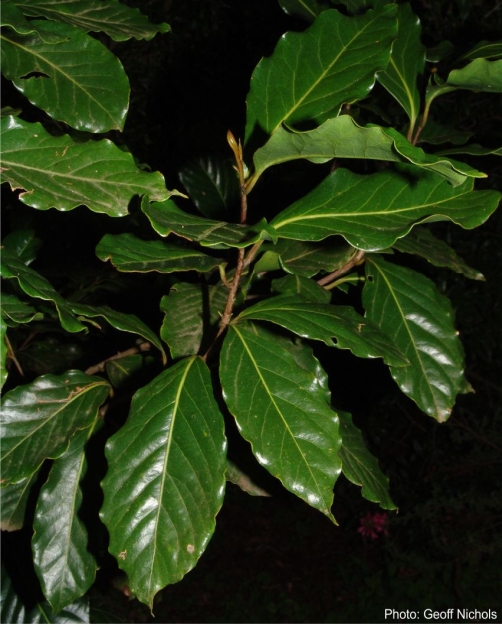
Description
Description
This is a large evergreen tree that can reach a height of about 30 m, with a rounded crown of many branches. The stem is straight, up to about 1.5 m in diameter, without branches for up to 8 m and with greyish-brown, smooth bark, covered in small, woody, black dots, and peeling off in large scales when old. Freshly cut bark produces a sweet smell. The Ocotea kenyensis has broad, glossy, leathery leaves which are dark green above and slightly aromatic. The leaves are 50-220 x 35-100 mm, alternate, elliptic, apex and base tapering, the margin is entire, wavy, and hairless. The petiole is 18 mm long.
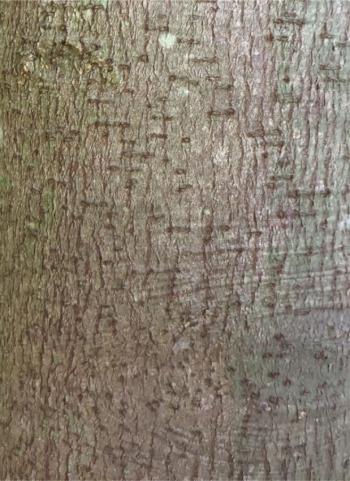
The flowers are small, white to cream, clustered near the ends of the branches in early to midsummer (Nov. - Jan.), in branched sprays, becoming brown as they age. Ocotea kenyensis fruits are globose berries, up to 27 x 14 mm, hard and fleshy with the fruit covered by a cup-shaped, flat cupule, giving them an appearance similar to an acorn, borne in late summer to autumn (Feb. - Apr.). The fruit is dark green, gradually darkening with maturity, the cupule at the base of the fruit can be more brightly coloured. The fruit has single seed covered in a hard coat.
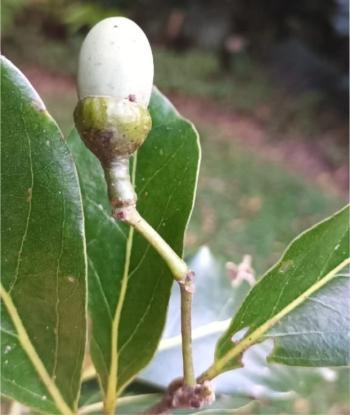
There are 2 species of this genus in South Africa. The other one is Ocotea bullata, known as Stinkwood. The difference between them is on the leaves: Ocotea bullata has blisters or bubbles on the upper surface and in Ocotea kenyensis the upper surface is smooth. This plant can also be confused with the Avocado, Persea americana, when it is young, they are closely related and belong to same family.
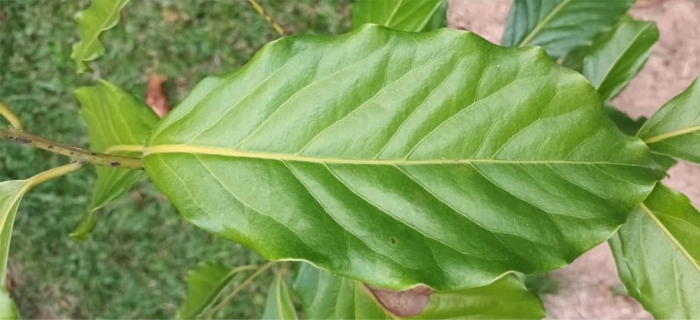
Conservation Status
Status
According to Red list of South African plants Ocotea kenyensis is Vulnerable (VU) but is Critically Endangered (CR) in Zimbabwe due to habitat destruction by forestry plantations. In South Africa, it is a naturally rare species, bark harvesting is not a problem, and no population decline has been reported.
Distribution and habitat
Distribution description
Ocotea kenyensis is a hardy plant that grows naturally in well-drained soil in evergreen rainforest, in mist belt forest on the Escarpment, at medium to high altitude where the normal rainfall is greater than 1 500 mm. The plant species grows together with species of Podocarpus, Albizia and Macaranga. It is found in eastern South Africa in the Eastern Cape through KwaZulu-Natal, Mpumalanga and Limpopo provinces, and in Eswatini, Zimbabwe, Mozambique, Tanzania, Ethiopia, Malawi, Rwanda, Sudan, Uganda and Kenya. Ocotea kenyensis grows in full sun, not shade.
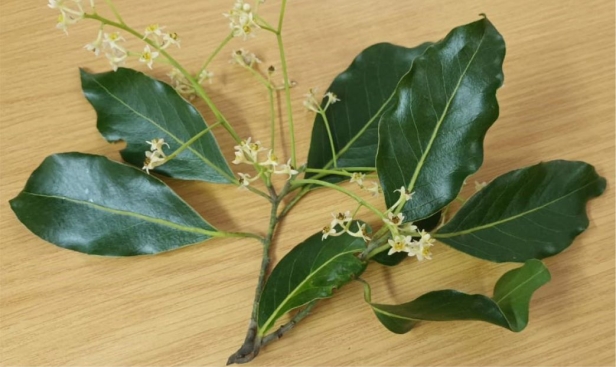
Derivation of name and historical aspects
History
Ocotea is a genus of angiosperm plants belonging to the family Lauraceae. There are 540 species currently accepted within the genus, it occurs in sub-tropical and tropical regions, mainly in the Americas but also in Africa, Madagascar, the Mascarene Islands, Canary Islands and Madeira. The genus name Ocotea is derived from the vernacular name for a stinkwood in French Guiana. The specific name kenyensis means ‘of Kenya’ because it was first collected and named in Kenya.
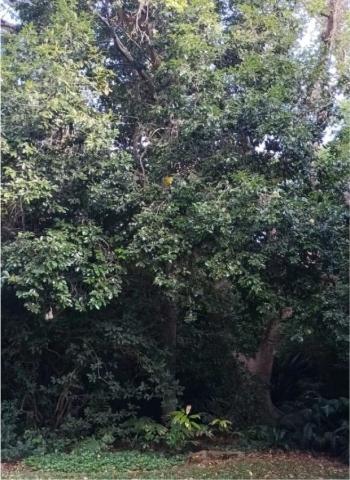
Ecology
Ecology
Many birds eat the fruit and disperse the seeds. Most of the Ocotea plant species can be attacked by various rot inducing root pathogens including Loweporus inflexibilis, Phellinus apiahynus and Phytophtora cinnamomi.
Other species are used as nesting sites by ants which may live in leaf pockets or in hollowed-out stems. The ants patrol its host plant constantly so that they can deter other insect pests such as grasshoppers.
The wood of Ocotea kenyensis is resistant to termites and marine borer attacks but is sensitive to beetle (Genus Lyctus) attack. Fruits are heavily attacked by insects.
Ocotea kenyensis trees coppice from the base.
Uses
Use
Ocotea kenyensis is best suited for big gardens because of its size. This plant species has been used as traditional medicines to treat different ailments, bark is used to treat diarrhea and cough. The heavy and durable wood of this tree is used for flooring, furniture, carving and paneling and it is suitable for light construction, joinery, interior trim, vehicle bodies, handles, ladders, sporting goods, toys, novelties, turnery, veneer and plywood and it is also used for fuel to make charcoal. The freshly cut wood lacks the offensive smell of Ocotea bullata.
Ocotea usambarensis, Ocotea cernua and Ocotea odorifera are used to produce essential oils which are rich in camphor and safrole. Species such as Ocotea puberula, Ocotea bullata and Ocotea usambarensis are harvested commercially to use for timber. Ocotea odorifera and Ocotea kuhlmanni are used as honey plants. Dried fruit cupules of Ocotea quixos are used in Ecuador to flavour beverages, such as colada morada.
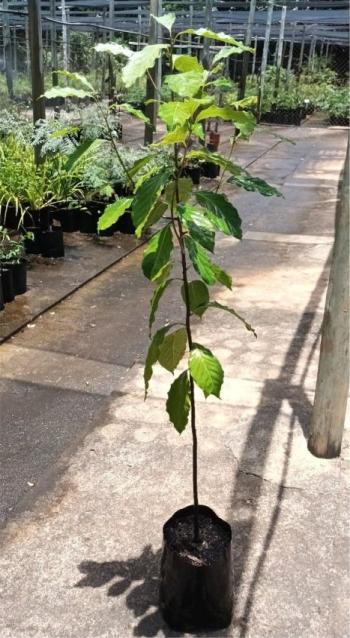
Growing Ocotea kenyensis
Grow
Ocotea kenyensis is easily propagated by root suckers and seeds. Seeds should be sown when they are still fresh, in a mixture of river sand and potting soil. The seeds take about 3 to 4 weeks to germinate.
Before transplanting the seedlings in individual pot, it’s better to harden them off because outdoor conditions are more harsh than those in the sheltered nursery environment. Expose them to outdoor conditions at least 7 to 14 days before transplanting. When seedlings are abruptly exposed to outdoor conditions, they can suffer damage and fail to thrive. Seedlings have a tender, fragile root system that cannot push through compacted soil, therefore, prepare a loose, well-drained mixture of potting soil and river sand for transplanting Ocotea kenyensis seedlings. Water the seedlings before removing them from the seed tray. Prick them out when they are 10 cm tall, using a wooden stick, handle them as gently as possible to avoid damage. Roots of transplanted seedlings should be completely covered. Place the transplanted seedlings under a shade net and water them twice a week.
Ocotea kenyensis is a fast-growing tree which grows wild in the moist tropics with an annual rainfall of 1 500mm to 2 500 mm. It prefers a position in full sun. It is suitable for sandy, loam and clay soils and prefers moist, well-drained soil. Suitable Ph is midly acidic, neutral or mildly alkaline.
Ocotea kenyensis can be planted in big gardens and used as a shade tree. The fruits are attacked by ants, insecticides are used to control the insects.
References
- Becking, D. n.d. Ocotea kenyensis. TreeSA. Online. https://treesa.org/ocotea-kenyensis/. Accessed on 16 Jan. 2023.
- Boon, R. 2010. Pooley's trees of eastern South Africa, a complete guide. Flora & Fauna Publications Trust, Durban.
- Plants of the World Online, Ocotea. https://powo.science.kew.org/taxon/urn:lsid:ipni.org:names:325868-2. Accessed 20/02/23.
- Schmidt, E., Lötter, M. & McCleland, W. 2002. Trees and shrubs of Mpumalanga and Kruger National Park. Jacana, Johannesburg.
- Verdcourt, B. 1996. Ocotea kenyensis in Flora of tropical East Africa. Accessed via JSTOR Global Plants. https://plants.jstor.org/compilation/ocotea.kenyensis.
- Wikipedia, Ocotea. https://en.wikipedia.org/wiki/ocotea. Accessed on 17 Jan 2023.
- Williams, V.L. & Raimondo, D. 2008. Ocotea kenyensis (Chiov.) Robyns & R.Wilczek. National Assessment: Red List of South African Plants version 2020.1. Accessed on 2023/02/20
Credits
Winfred Ngwenya
Lowveld National Botanical Garden
March 2023
Plant Attributes:
Plant Type: Tree
SA Distribution: Eastern Cape, KwaZulu-Natal, Limpopo, Mpumalanga
Soil type: Sandy, Clay, Loam
Flowering season: Late Summer
PH: Acid, Neutral
Flower colour: White, Cream
Aspect: Full Sun
Gardening skill: Easy
Special Features:
Horticultural zones







Rate this article
Article well written and informative
Rate this plant
Is this an interesting plant?
Login to add your Comment
Back to topNot registered yet? Click here to register.